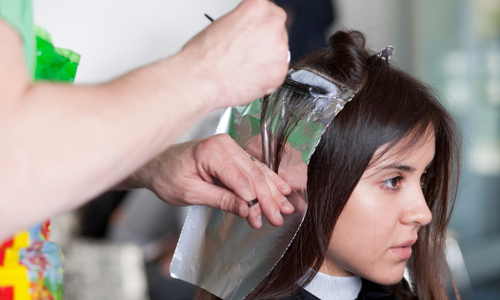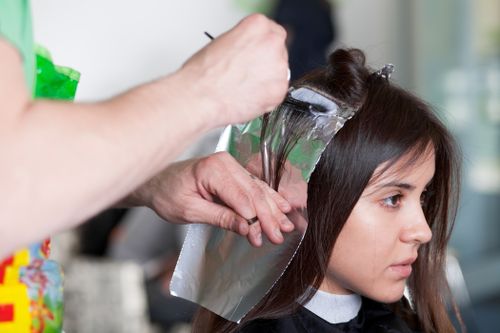
33 Toxic Hair Straighteners Under International Recall Still Sold in U.S.

Thirty-three hair-straightening products have been recalled over the last three years in several countries due to high levels of formaldehyde, however, the U.S. has yet to pull the toxic products, according to new research from the national nonprofit Women’s Voices for the Earth (WVE).

The issue has alarmed many consumers given that formaldehyde (also called methylene glycol) can cause severe eye, nose and throat irritation and increase cancer risks.
The increased risks to salon workers alone, who offer hair-straightening treatments, merits further investigation, said Alex Scranton, director of science and research at WVE.
“Based on sound science, other countries are taking strong measures to protect the health of salon workers and their customers from formaldehyde-containing products,” said Scranton. “While U.S. government regulations continue to fall short, consumers deserve to know what’s in their products in order to make safer decisions about their hair care.”
Formaldehyde Effects
Natalija Josimov used to swear by hair-straightening treatments for her own coarse, frizzy hair. When she became a hair stylist in 2009, she said she was eager to offer the service to her clients. But just nine months after launching her career, she experienced chronic sinus and respiratory infections, painful blisters in her nose and heart palpitations—all caused by formaldehyde gas released during treatments.
“I think many stylists performing these treatments are under the mistaken impression that the Food and Drug Administration (FDA) would not allow these products on the market if they were dangerous,” Josimov said. “It took me doing at least 100 treatments before I realized it was making me so ill, and I still have side effects from it.”
Josimov is part of a growing number of stylists and consumers concerned about toxic chemicals in hair-straightening products and the double standard that allows formaldehyde-containing products to be sold in the U.S., despite being banned by the European Union Commission.
Stories like Josimov’s led WVE to release a new fact sheet alerting stylists and customers to the international recalls of hair-straightening products.
The Cosmetic Ingredient Review (CIR), an industry-funded and operated panel that assesses the safety of cosmetic ingredients in the U.S., declared that formaldehyde was unsafe to be used in hair straightening products in March 2011.
The FDA lacks the authority to issue a mandatory recall of cosmetic products that have been found to cause health problems to consumers. In fact, the agency has yet to issue a voluntary recall of Brazilian Blowout, the first hair straightener found to contain high levels of formaldehyde. The original formula of Brazilian Blowout was ordered off the market in California by the California Attorney General in 2012 for violating California air pollution regulations.
See below which toxic hair straighteners remain on the market, which have been banned or recalled, and which are formaldehyde- free:
International Recalls of Hair StraightenersProducts that have been recalled in other countries, but which are still for sale in the U. S. This list is not exhaustive. There may also be other hair straightening products containing formaldehyde. |
|||
|
Brand/ |
Product Name |
Level/Range of Formaldehyde |
Countries Where Recalled |
|
BioNaza Cosmetics |
KeraHair – Premiere Brazilian Keratin System |
.7-2.5% |
|
|
BioNaza Cosmetics |
Choco Hair – Brazilian Keratin Chocolate |
1.2-1.8% |
|
|
BioNaza Cosmetics |
Diamond – Premiere Brazilian Keratin System |
0.8-1.7% |
|
|
BioNaza Cosmetics |
KeraVino Premiere Brazilian Keratin System |
0.9-1.6% |
|
|
Brazillian Blowout |
Brazillian Blowout Acai Professional Smoothing Solution Brazillian Blowout Solution |
6.4- 8.8% |
|
|
Cadiveu |
Brazillian Thermal Reconstruction |
7% |
|
|
Cocochoco Professional |
Complex Brazilian Keratin Straightening Treatment |
3% |
|
|
Coppola/Copomon Enterprises LLC |
Keratin Complex Smoothing Therapy |
2% |
|
|
Coppola/Copomon Enterprises LLC |
Keratin Complex Express Blowout |
>.2-1.7% |
|
|
Coppola/Copomon Enterprises LLC |
Keratin Complex Intense RX, Smoothing Therapy |
0.5-0.8% |
|
|
Global Keratin |
Global Keratin Taming System with Juvexin Strawberry Resistant |
4.40% |
|
|
Global Keratin |
Global Keratin Taming System Strawberry |
3.00% |
|
|
Global Keratin |
Functional Keratin Hair Taming System Blond/Light Wave Colored “Chocolate” |
1.7% |
|
|
Global Keratin |
Global Keratin Taming System with Juvexin Strawberry Light Wave |
.2-1.4% |
|
|
Global Keratin |
Global Keratin Hair Taming System with Juvexin Light Wave/Curly |
>.2% |
|
|
Goleshlee |
Goleshlee Keratin Hair Therapy |
>0.6% |
|
|
Hair Go Straight |
Keratin Treatment |
2.60% |
|
|
I.B.S Beauty Inc. |
Istraight Keratin Advanced Keratin Treatment |
2.30% |
|
|
Inoar |
Moroccan Hair Treatment |
2.84%-7% |
|
|
KeraStraight |
Treatment Original Formula |
2% |
|
|
La Brasiliana |
Zero (apple) |
0.76% |
|
|
La Brasiliana |
Veloce |
0.35% |
|
|
La Brasiliana |
Spruzzi |
> .2% |
|
|
La Brasiliana |
Domani |
> .2% |
|
|
La Brasiliana |
Original |
> .2% |
|
|
Lazaros general trading LLC |
TCQ Plus Phase 2 – Nano Hydra Keratin |
2.30% |
|
|
Marcia Teixeira – M & M International |
Chocolate, extreme de-frizzing treatment |
2% |
|
|
Marcia Teixeira – M & M International |
Advanced Brazilian Keratin Treatment |
1.70% |
|
|
Marcia Teixeira – M & M International |
Brazilian Keratin Treatment, Marcia Teixeira |
1.60% |
|
|
R & L Trading Corp |
Soft-Liss Intelligent Brush Morango Step 2 |
>0.2% |
|
|
Rio Keratin |
Brazilian Keratin Treatment Step 2 Grape Extract |
3.50% |
|
|
Royal Keratin Professional Line by Keratin Connection |
Brazilian Keratin Treatment in Mint, Chocolate, Strawberry |
1.54% |
|
|
Tahe |
Thermo Keratin No. 2 Active Treatment |
>0.2% |
|
Hair Straighteners High in Formaldehyde, Not Yet RecalledProducts that have been tested and found to contain formaldehyde higher than acceptable levels in other countries, but have not yet been subject to recall. |
|||
|
Brand/ Manufacturer |
Product Name |
Level/Range of Formaldehyde |
|
|
Brazillian Gloss |
Keratin Smoothing Gloss |
7.30% |
|
|
Kera Green |
Keratin and Protein Hair Treatment |
1.50% |
|
|
Keratin Express |
Keratin Express Brazilian Smoothing Treatment |
1.2% |
|
|
QOD |
Max |
3.52% |
|
| QOD | Gold Solution |
2% |
|
| Simply Smooth / American Culture Hair | Brazilian Keratin Treatment |
0.93% |
|
| Simply Smooth / American Culture Hair | Xtend Keratin Replenishing After Color Lock |
0.55% |
|
Formaldehyde-Free Hair StraightenersThe following products have been tested and found not to contain measurable levels of formaldehyde. This list is not exhaustive. There may also be other hair straightening products which do not contain formaldehyde. |
|||
|
Brand/ Manufacturer |
Product Name |
Level/Range of Formaldehyde |
|
|
JKS International |
JKS Smoothing Treament |
0% |
|
|
Bio Ionic |
Bio Ionic Kera Smooth Anti Frizz Treatment for Virgin Resistent Hair |
0.01% |
|
|
Pravana Naturceuticals |
Pravana Naturceuticals Keratin Fusion |
0.01%
|
|
Visit EcoWatch’s HEALTH pages for more related news on this topic.

 233k
233k  41k
41k  Subscribe
Subscribe 
